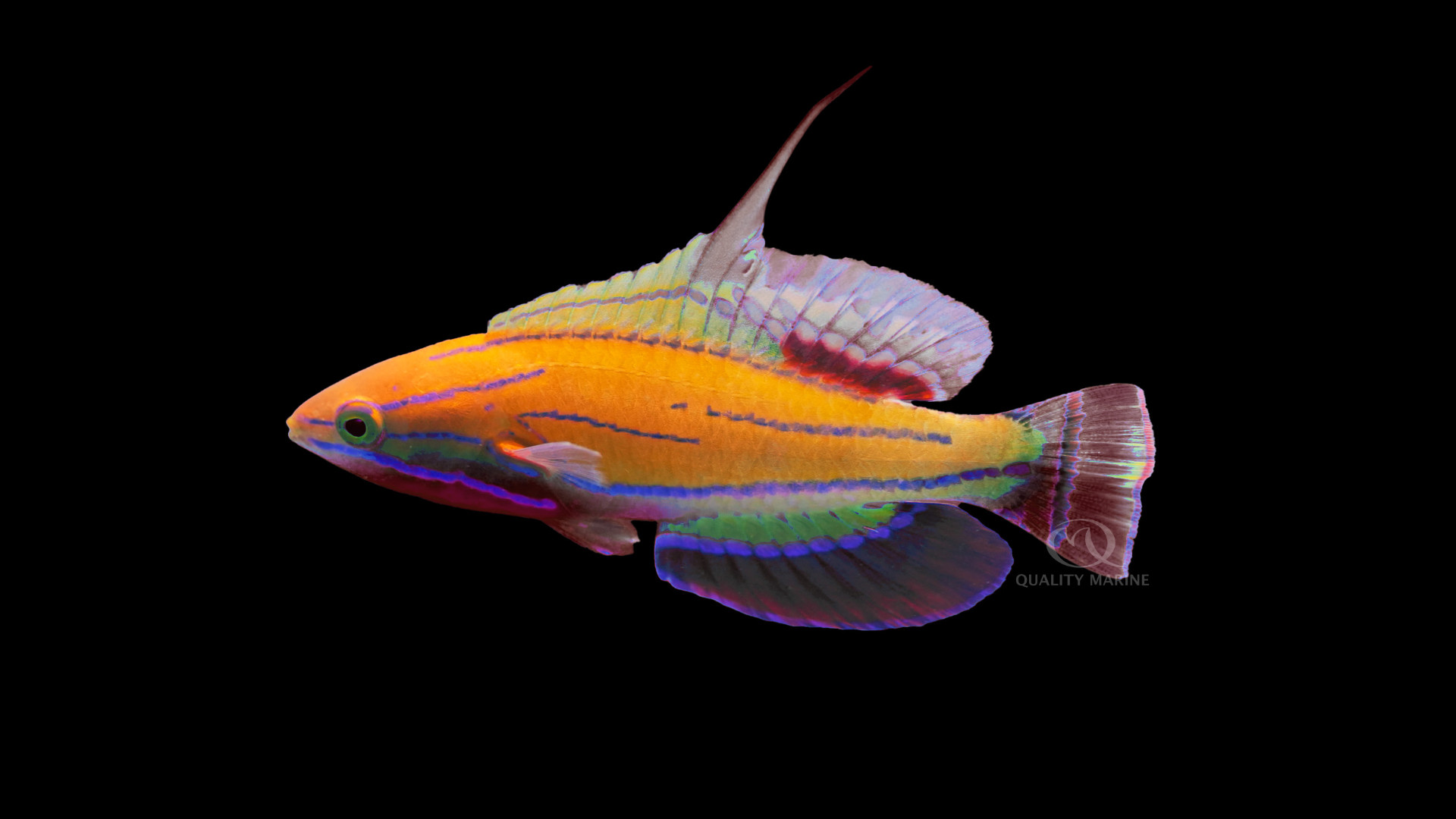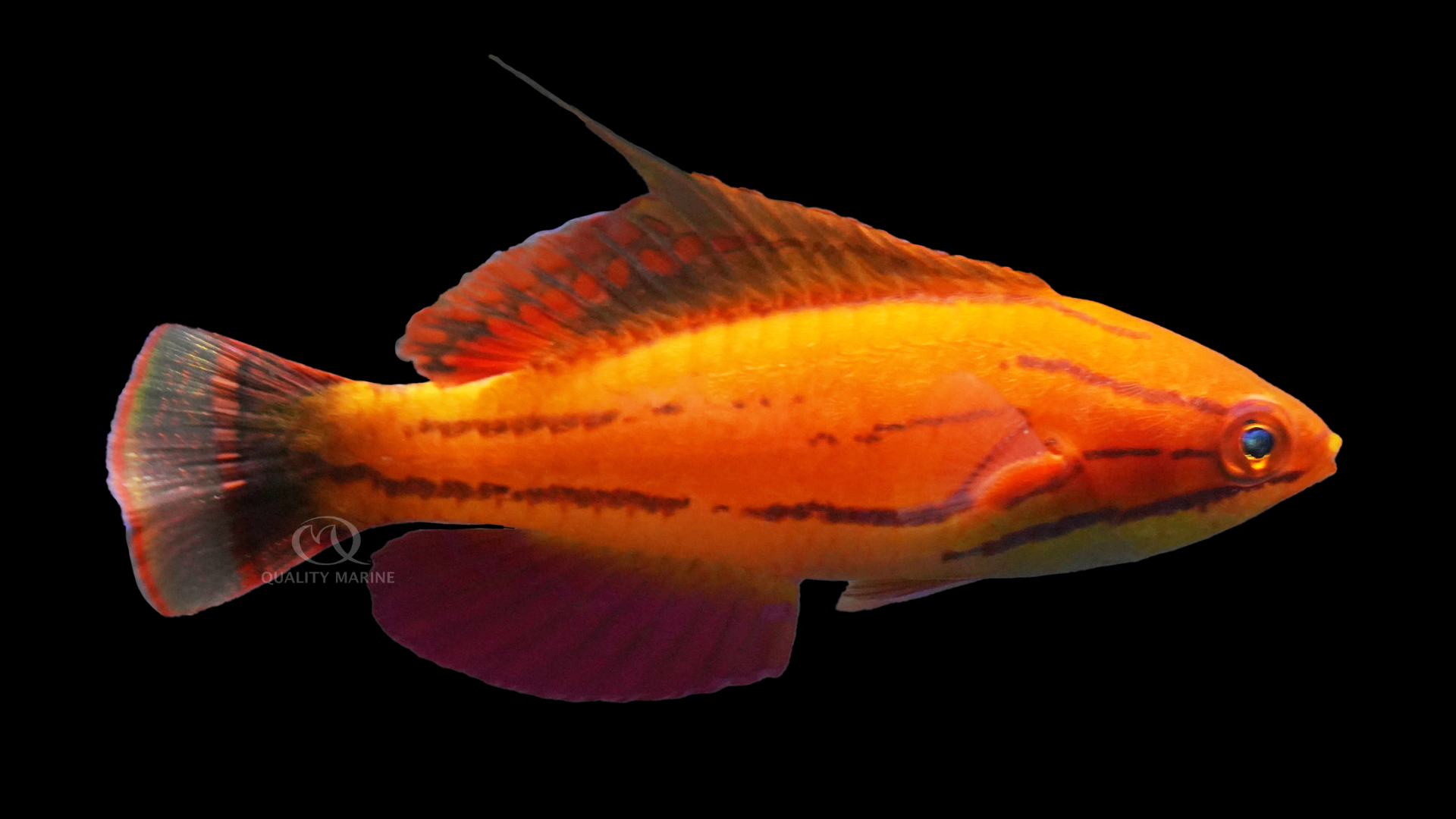The Flashiest McCosker

What fish is small, peaceful, likes to harem up, is totally reef safe, and absolutely gorgeous, while not being hundreds of dollars a fish? May I present to you, McCosker's Wrasse aka Paracheilinus mccoskeri. These fish tick all these boxes, and while not as inexpensive as, let's say, Yellow Tail Damsels, they are much less aggressively priced than some of the uber rare members of their genus (looking at you P. hemitaeniatus and P. piscilineatus). McCosker's Wrasse interestingly only have a few common names, worldwide. The other two are questionable indeed as in Mandarin Chinese, these are referred to as 麦氏副唇 and google translates this as “mackerel.”
The last remaining common name comes from Poland where the fish is allegedly called Zarlacz kalifornijski or, according to google translate: “the California Shark,” and this name also seems curious to us. While McCosker's Wrasse has a huge range, coming from all over the tropical Indian and Western Pacific oceans, one place it does not come from is California, and it is very obviously not a shark of any kind. In places where you do find these fish, they are nearly always living in small groups, suspended near drop offs adjacent to reefs, rubble or algae. They're commonly found as shallow as 20 feet down, and as deep as about 130 feet. They live in harems, where several females group together, and males will swim between groups of females, or guard one group closely.
McCosker's Wrasses are very straightforward to keep. As long as you have a stable aquarium with parameters that you are very used to hearing about, they'll be fine. The big three values should be close to these: SG - 1.024 (+/-.002), pH – 8.0 (=/-.2) and temperature should be in the mid 70s Fahrenheit, don't let this get lower than 72 or higher than 80. As with most of the things you're likely to keep in an aquarium, nutrients should be kept in check with filtration and regular water changes with a quality salt like Tropic Marin. These water changes will also ensure that the buffers and mineral content of the water will not be depleted over time, resulting in a more stable tank, and happier / healthier fish (and inverts).

In regard to the display for McCosker's Wrasses, they should always be kept in groups if possible and as such, because you're going to have at least one female and one male (though two or three females would be preferable), you should aim for a 55-gallon aquarium or more. This aquarium should have lots of rocks for your fish to hide in, the more rocks the better as Paracheilinus mccoskeri loves hiding places; there more there are, the bolder they will feel and the more you will see your fish. Your McCosker's will also sleep in the cracks and crannies of your rockwork. Because of this, they don't need a sand bed, and are good candidates for bare bottom tanks. The tank you keep them in should be covered as these wrasses will jump when scared and can easily jump out of the tank. Give them lots of flow and lots of places to hide and swim.
Paracheilinus mccoskeri is a very active fish and will need at least two meals per day. They are also very shy fish and will initially be hesitant to come out of hiding with you near the aquarium. They will soon associate you with food and their reticence will pass. Feeding shy, hungry fish is probably the biggest challenge facing aquarists in keeping Flasher Wrasses of any sort. Here we feed twice a day and they get a mix of finely chopped meaty foods and are introducing them to pellets at the same time. They learn to associate the pellets with the things more easily recognized as food pretty quickly. This is something we suggest you continue, until you are able to utilize only pellets for one of their meals, which might also allow you to use an auto feeder for the dry portions of their diet. This would allow you to feed them smaller amounts more times a day without any extra effort; though we find twice a day to be enough for their needs, some aquarists like to spread these meals out, and this is one of the best ways to accomplish that.
As a shy fish, some care should be taken in your choice of tank mates as well. Very boisterous or aggressive fish will make it difficult for your McCosker's Wrasses to compete at feeding time. Temperament wise, they will get along with pretty much anything, including basically every invertebrate you can imagine them sharing space with. They are safe with corals of all sorts, clams, feather dusters, gorgonians, cleanup crew members, you name it. The only invert we would caution you about is very strong anemones like Carpet Anemones or Heteractis. As your flashers will dart about and use their speed as a defense in panic situations, they can find themselves as a meal; a tragedy for you and for the wrasse. Good choices for other fish would be things like Dartfish, Halichoeres and Pseudojuloides Wrasses, Chromis, most Clownfish, Cardinals etc.
The McCosker's Wrasse is well suited for aquarium life and the males are absolutely worthy of being the showpiece in any aquarium. The females are beautiful in their own right and the interplay between them all is fascinating to watch for everyone. These fish are straightforward to keep, pretty hardy and as reef safe as any fish could possibly be. Head over to your Local Fish Store and ask them to get you some sustainably sourced McCosker's Wrasses from Quality Marine today.